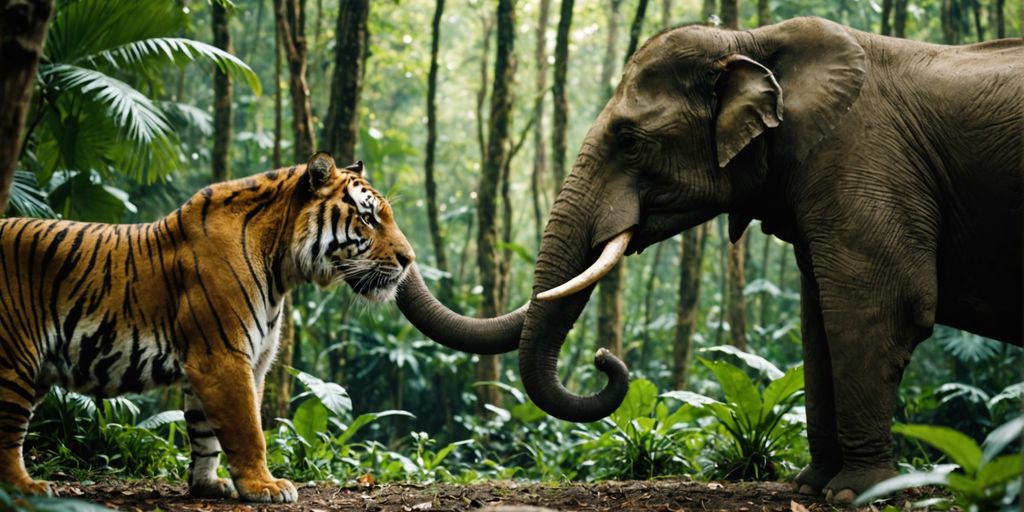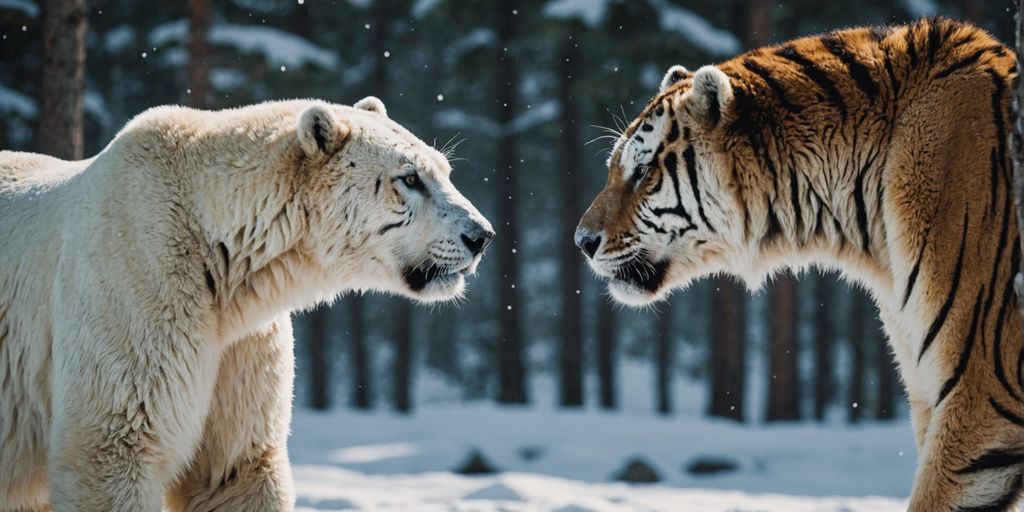Your Cart is Empty
🙏HELP US SAVE TIGERS!🐅 WE DONATE 1% OF OUR SALES TO WILDLIFE ORGANIZATIONS ( WWF ...)
Menu

🙏HELP US SAVE TIGERS!🐅 WE DONATE 1% OF OUR SALES TO WILDLIFE ORGANIZATIONS ( WWF ...)
The Malaysian Tiger
May 28, 2021 4 min read

The Malayan tiger, also called harimau belang by local people, is a subspecies of the tiger living in the south and center of the Malaysian peninsula in Southeast Asia. Its population was estimated between 493 and 1480 individuals in 2003. Unfortunately, due to its difficulty reproducing, its population is decreasing rapidly, and there are much fewer of them today.
It is also often confused with the Indochinese tiger, and it is not surprising, they look very similar. It would help if you probably had difficulty differentiating them too. But they are indeed two different subspecies! This has been officially recognized since 1968, thanks to extensive genetic analysis on other specimens. 🐯
In this article, we will explain the difference between these two types of tigers and everything you need to know about the Malayan fawn. Whether it's its weight, size, breeding method, or what it represents in the Malaysian culture, you will learn everything about this big cat.
Let's go without further ado on the big Malaysian striped fawn tracks!
Physical Characteristics
First of all, let's talk about what characterizes the Malayan tiger and what differentiates it from other members of its species. We will see from now on that it is not the easiest felid to recognize. And it is also far from being the most imposing tiger and even less the frailest of the hairballs.
Size and Weight
First of all, this felid is much smaller than the Bengal tigers (which, as a reminder, live mainly in India). Unfortunately, given the few individuals and is considered a subspecies in its own right recently, the only present data comes from only a few specimens (11 males and eight females, to be more precise). These data thus remain completely approximate! 🧑🔬
The males measure an average of 2 meters 50 in length for approximately 120 kg. The females, as for them, calculated 2 meters 39 for about 100 kg. It can be noted that the difference in height and weight between the two sexes is fragile.
How to differentiate it from other tigers?
As for the Malayan tiger and the Indochinese tiger, it is tough to differentiate them (if not impossible) at first glance by their appearance. As we said in our article ''Why does the tiger have stripes?'', apart from the region where they are observed, their size, or DNA analysis, there is no other way to identify them more clearly.

Habitat and distribution
We already know that the animal is present in Malaysia. Still, we do not know if it is visible outside the country, particularly in Thailand, where the Indochinese tiger is present. Surely, it is present in the extreme south, near the Thai border. Tropical and subtropical forests are their primary habitat.
Diet
The Malayan tiger, like its colleagues and other felines, has a carnivorous diet. It is a powerful predator that attacks wild animals and sometimes even domestic livestock by surprise (which causes it a lot of trouble). 🥩
Its usual diet includes muntjacs, sambars, wild boars, bearded pigs, deer, tapirs, goats, monkeys, and other wild hogs. When the opportunity arises, it may prey on the offspring of large animals such as elephants, rhinoceroses, and bears.
Breeding
This big cat lives between 12 and 25 years (depending on whether it lives in captivity or not). They are mammals, giving birth to tiger cubs after a gestation period of about 3.5 months. Usually, three or four cubs are born. 🐅
Tigers are solitary creatures; they only meet to breed. The cubs stay with their mother until about 18 months of age when they separate and become independent. They, in turn, can mate from the age of about four years.

The Tiger of Malaysia, A Great Symbol
The Tiger in Malaysian Culture
The tiger is widely recognized in the culture simply because it is the national animal of Malaysia. They are notably present in the coats of arms of many states of the country and on the coats of arms of the royal police, Maybank, one of the largest banking groups in the country, and the soccer federation of Malaysia. ⚽
In short, it is a symbol present on many badges, crests, shields, stories, legends, and many more. Let's find out without further ado!
The Controversy Around the Name
First of all, when the Malayan tiger was recognized as a subspecies, the news pleased the Malaysians. Its scientific name Panthera tigris jacksoni, given in honor of Peter Jackson, a great tiger specialist, was quickly a subject of controversy.
The MAZPA (Malaysian Association of Zoos, Parks, and Aquariums) protested that the name should reflect the range of this cat and other tigers (Bali, Siberia, Bengal, etc...). They proposed the name Panthera tigris Malaysia.

The Tiger of Malaysia Threatened?
The (IUCN) International Union for Conservation of Nature claims that (IUCN), this subspecies is in danger of extinction. Some zoos have set up captive breeding programs to protect the species, but unfortunately, this is not enough! Their population is still on the decline.
It is poaching to meet Asian demand for body parts used in traditional Chinese medicine, excessive logging, conversion of forests into farmland, and urban expansion. Here are some of the reasons for its decline, among others. 😟
If we don't react quickly, the Malayan tiger may well join the three subspecies of tiger now extinct. Fortunately, there is a vast breeding facility in Malaysia to help increase the population of Malaysian tigers.
Several Malaysian tigers have been successfully bred in recent years, and their cubs have been sent to zoos around the world to learn about their environment and be healthy. Tiger conservation organizations need our support now more than ever to save not just this subspecies, but the entire tiger species, which will be extinct forever unless we act quickly. ⚰️
To support the preservation actions of this big cat, Tiger-Universe donates 10% of its turnover to the WWF association. By buying on our store, you become an actor for this noble cause! You can now discover one of our flagship collections, the tiger T-shirts, by clicking on the image below!
Also in Tiger Blog

Sloth Bear vs Tiger: Who Would Win?
July 13, 2024 7 min read
Explore the thrilling showdown between a sloth bear and a tiger, analyzing their strengths, behaviors, and survival tactics.
Read More
Tiger vs Elephant: Who Reigns Supreme in the Animal Kingdom?
July 13, 2024 7 min read
Explore why elephants usually triumph over tigers in the wild, highlighting their size, strength, and defensive prowess.
Read More
Epic Battle: Polar Bear vs Tiger, who win?
July 11, 2024 8 min read
Epic showdown: Polar Bear vs Tiger. Discover who would win in this thrilling battle of nature's fiercest predators.
Read More
